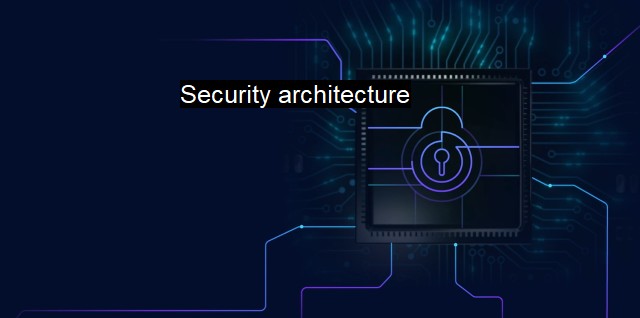What is Security architecture?
The Crucial Role of Security Architecture in Cybersecurity: Designing and Managing Preventive and Detective Mechanisms to Protect Corporate Assets
Security architecture plays an immense role in keeping the face of technology and systems safe. It plays a significant part in the field of cybersecurity. But what exactly does the term "security architecture" mean? In simple words, it is a framework or blueprint of systems and measures implemented to control and manage security in an organization's network. It guides and designs how different parts of the cybersecurity system would work together to create an entire safe environment.The elements within security architecture invigorate the strategy, goals, and operations of an organization's network and IT system, making it of paramount importance in antivirus protection and maintaining cybersecurity. Security architecture envelops several features - processes, hardware and software designs, web services, protocols, and policies. It lays the groundwork for the design, implementation, and monitoring of security controls that ensure the safety of a variety of IT systems and data.
Security architecture is designed to provide a detailed plan for a secure IT solution, checked against a roadmap or guidance and applicable use cases. It presents a holistic view of all cyber capabilities, interconnectedness, threats, and processed data and offers risk mitigation strategies and privacy protection measures to safeguard crucial data and systems.
When diving into the finer structure of security architecture, we come across layers of defense, also known as 'Defense in Depth'. This architecture concept introduces multiple defensive layers aiming to avoid single points of vulnerability and provide overall resilience to threats. The architecture should, therefore, provide controls at every intersection where data is received or transmitted, ensuring every weak spot is monitored and defended.
Talking about the role of security architecture in terms of antivirus protection, it's vital in structuring a well-readied framework that fends off any malware or intrusive viruses. Security architecture aids in morphing an active antivirus system that guards against undiscovered threats, overcomes vulnerabilities, and most importantly, conveys a multi-layered defense architecture to cope with sophisticated malicious threats.
Security architecture acts as a whistleblower to detect and isolate unusual activities and potential threats. It incorporates intrusion detection systems, thus helping to front-load security measures in the scheme of cybersecurity. As it's powered by a variety of security measures and strategies, security architecture responds to continually mutating cyber threats and cyber attributes.
Security architecture's emphasis on maintaining the triumvirate of Confidentiality, Integrity, and Availability (also known as the CIA triad) is significant. Confidentiality ensures that sensitive information remains exclusively accessible to those authorized to view it. Integrity confirms that the data's consistency, accuracy, and reliability remain throughout its entire life-cycle. While Availability guarantees that the information is ready for authorized users when required in a timely and reliable manner.
Inevitable as it is, there will always be malicious forces aiming to bring harm to IT systems, networks, and data. Nonetheless, the potential magnitude of damage frequently depends on how robust an organization's security architecture is. For enterprises, acquiring a strong, well-rounded understanding of security architecture is essential to rotating the cyberspace from a threatening environment to a more secure space.
Security architecture, in the wider context of cybersecurity and antivirus, is an indispensable instrument shielding the digital world. It is an element that forms the foundational principle ensuring the secure functioning of IT systems and networks, all the while comprehensively linking together other cybersecurity efforts. It enables businesses and organizations to adequately preserve and protect their data from numerous digital threats, mindfully creating a safe and reliable cyber environment. Without a well-defined security architecture, an organization can find itself vulnerable to greatly disastrous cyberattacks, potentially disrupting its whole functioning.

Security architecture FAQs
What is security architecture?
Security architecture refers to the design and structure of a system's security measures. It includes the policies, procedures, and technologies that are intended to protect the system from various security threats such as viruses, malware, and unauthorized access.Why is security architecture important?
Security architecture is important because it helps organizations protect their valuable assets, including sensitive data, intellectual property, and financial resources. Effective security architecture can help prevent cyber attacks and minimize their impact, which can save a company from significant financial losses and reputational damage.What are some key components of security architecture?
Some key components of security architecture include access control, encryption, firewalls, intrusion detection/prevention, and antivirus software. Access control helps ensure that only authorized users can access sensitive data or systems, while encryption protects data from unauthorized access or tampering. Firewalls and intrusion detection/prevention systems help detect and block malicious traffic, while antivirus software helps protect against viruses and malware.How can organizations ensure that their security architecture is effective?
Organizations can ensure that their security architecture is effective by conducting regular risk assessments, staying up to date with the latest threats and vulnerabilities, and implementing industry-standard security best practices. It's also important to ensure that all employees are trained on security awareness and that the organization has a response plan in place in case of a security incident. Additionally, organizations can consider working with security professionals or hiring a dedicated security team to help design, implement, and manage their security architecture.| | A | | | B | | | C | | | D | | | E | | | F | | | G | | | H | | | I | | | J | | | K | | | L | | | M | |
| | N | | | O | | | P | | | Q | | | R | | | S | | | T | | | U | | | V | | | W | | | X | | | Y | | | Z | |
| | 1 | | | 2 | | | 3 | | | 4 | | | 7 | | | 8 | | |||||||